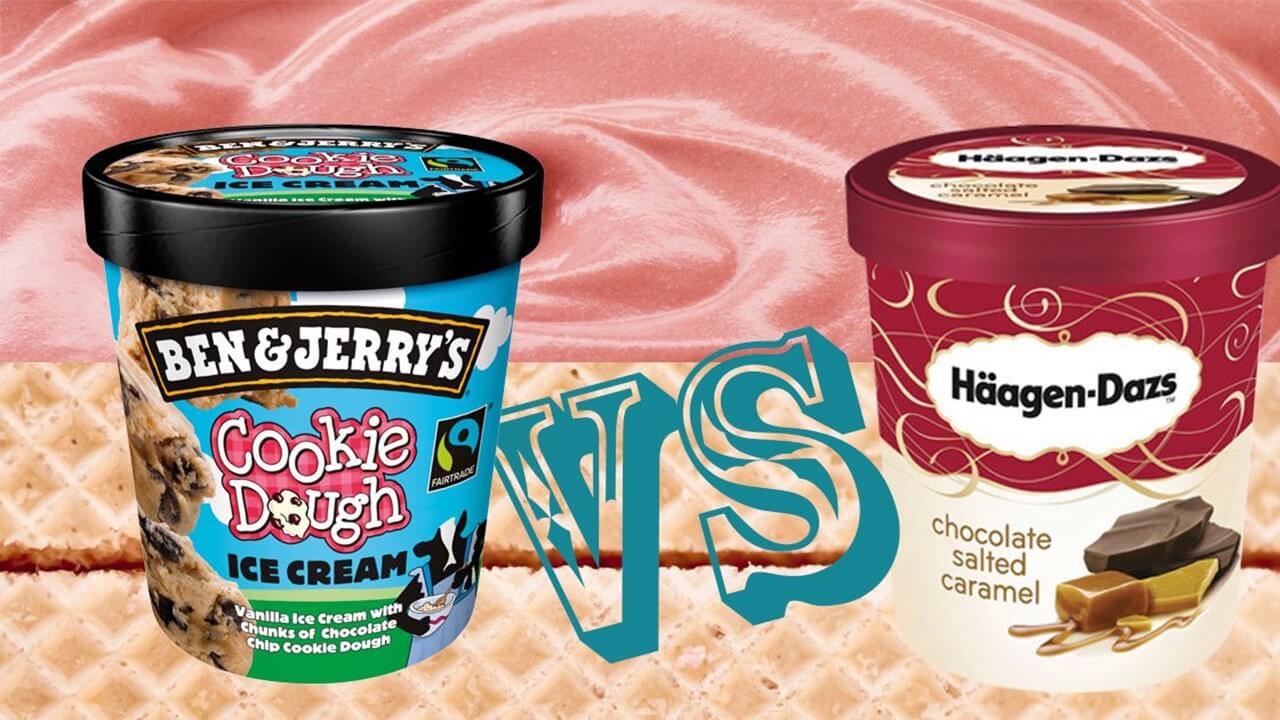Note: This is the second in a four-part series from Idea Grove‘s CEO Scott Baradell, on competing successfully with larger competitors by “punching up.”)
Ben & Jerry’s Ice Cream is a household name. Their colorful pints with oddly named flavors — such as Cherry Garcia, Chubby Hubby, and Half Baked — fill the frozen dessert aisle of every grocery store across America. Their success is no accident.
Since the beginning, they understood their position in the market and how a distinct, consistent message could elevate them against larger competitors. Most importantly, they knew that ice cream is supposed to be fun. While more established brands were conservatively touting “homemade” as a selling point (whatever that means), Ben & Jerry’s was having a good time and sharing those good vibes with their enthusiastic customers.
$12,000 and an Old Gas Station
The origin of Ben & Jerry’s is so quaint, it almost feels like something out of a Hallmark movie. Ben & Jerry’s is named after, as you would imagine, a man named Ben and a man named Jerry. Ben Cohen and Jerry Greenfield were childhood friends. They wanted to start a business together. Originally, they considered bagels, but the equipment was too expensive. So instead, they decided on ice cream. In 1977, they completed a correspondence course on how to make ice cream. A year later, with only $12,000, they opened an ice cream parlor in an old gas station.
It was a rocky road (pun intended) for the fledgling company. As they mention in their memoir Ben & Jerry’s Double-Dip, published in 1997 by Simon & Schuster: “Our portion control was out of control; we were hiring our friends and then agonizing over supervising them; our financial records were usually located in the back pocket of Ben’s jeans. We were having fun, but we weren’t exactly mastering the art of retailing.”
Despite all those challenges, their ice cream grew in popularity across New England. But with their success, they gained the unwanted attention of larger competitors. By the mid 1980s, Häagen-Dazs tried to keep them out of stores. The ice cream giant allegedly told distributors to cease dealing with Ben & Jerry’s as a condition for continuing business with Häagen-Dazs.
Ben & Jerry’s decided to sue Häagen-Dazs, which at the time was owned by Pillsbury, for “restraint of trade” under federal antitrust law. Ben & Jerry’s lawyer told them it was a no-win situation to take a larger corporation to court. The Federal Trade Commission would not act on their behalf, and Ben & Jerry’s money would inevitably run out before Pillsbury’s money would. (At the time, Pillsbury was worth over $4 billion.) Cohen and Greenfield decided to leverage media pressure to help their cause.
What’s the Doughboy Afraid Of?
Ben & Jerry’s began printing the phrase “What’s the Doughboy Afraid Of?” on all their ice cream packaging, along with a 1-800 number. Customers who called the number received addressed letters, statements of support for Ben & Jerry’s, which they could send to the Federal Trade Commission and the Pillsbury chairman—along with a bumper sticker.
Ben & Jerry’s also used low-cost advertising and guerrilla marketing efforts. They posted a classified ad in Rolling Stone magazine and purchased bus signs depicting the hands of the Pillsbury’s Doughboy literally strangling a pint of Ben & Jerry’s ice cream. The messaging was over-the-top and mysterious, prompting more people to call the 1-800 number. They organized a one-person protest outside the Pillsbury corporate headquarters, and even held a press conference where only one reporter showed up. All of it was designed to highlight their underdog status.
It was an audacious maneuver—“trolling” before trolling was even a thing. However, the campaign got the attention of national media outlets. In 1985, the New Yorker wrote a feature article about the David and Goliath battle between the two companies.
While Ben & Jerry’s seemed like an underdog, in hindsight, it’s clear to see that Pillsbury didn’t stand a chance against these tactics. The lawsuit was settled out of court, and Häagen-Dazs backed off from its efforts to restrict distribution of their puckish competitor.
Four Lessons on Punching Up
The Pillsbury legal battle is one example of a fledgling Ben & Jerry’s taking on the competition. However, it’s indicative of the overall fighting spirit that this brand has always had. Here are a few learnable lessons on how they’ve succeeded in a well-established marketplace.
Lesson 1: Understand the value of “free”
To celebrate their first year as a business, Ben & Jerry’s held a “Free Cone Day” to thank their customers. Now, it’s an annual event, held between late March and early May, at all 615 store locations. The marketing event has been wildly successful for Ben & Jerry’s, creating a community of fans.
The important thing to understand is they aren’t simply giving away free ice cream without a plan in place. The cones are smaller than usual, almost sample size. They aren’t risking bankruptcy from free ice cream. However, “free” still has allure when it’s offered in conjunction with a lively shared experience. Free Cone Day takes on the significance of a federal holiday. Fans anticipate the next year and the next, sharing their enthusiasm with friends on social media.
Does your company have its own holiday? In 2002, 7-Eleven took a cue from Ben & Jerry’s with Free Slurpee Day on—of course—July 11. Boston Market celebrates National Rotisserie Chicken Day on June 2. The direct sales cookware company Saladmaster has 316 Day on March 16. They celebrate the 316Ti Stainless Steel used in their cookware. And on August 5, 2003, underwear retailer Freshpair created National Underwear Day.
It’s not enough to pick a day on the calendar. Your brand needs to take that opportunity to go big and earn your audience’s attention. Few things turn heads quite like “free.”
Lesson 2: Whimsy can be good for your brand
When did marketing directors decide that whimsy was universally a bad thing? Everyone seemingly decided that brands should only be taken seriously and respected. As a result, every marketing campaign feels overly traditional and sentimental. Is it any wonder that “child finally goes off to college” is the default plot for so many commercials? Even ice cream takes itself way too seriously — where every bowl is eaten on a back porch of grandma’s house, obviously, right before your child finally goes off to college. The spoon is held by a responsible adult who looks off thoughtfully into the distance. It’s boring.
In contrast, Ben & Jerry’s is fun. The ice cream names are all pop culture references and bad puns. This is not back porch ice cream; think dorm room instead. The brand skews toward that kid shipped off to college. It’s more Rolling Stone than Reader’s Digest, more indie rock than adult contemporary.
This whimsical disposition goes beyond the packaging and the advertising. At their corporate office, they have an actual graveyard where they bury the ice cream flavors that failed. There is also a tree house and slide in the building. Employees are allowed to bring dogs to work.
Does your company take itself too seriously? Maybe it’s time to consider a little levity in your operations. It’s not just about being funny — as jokes can hit or miss. Instead, you focus on ways to humanize your operations with personal touches that show you aren’t afraid to be playful and enjoy your work.
Lesson 3: Celebrate your activism
Of all the lessons, this is one that most companies will probably ignore. And for good reason! It’s not easy to be actively engaged with social justice. Companies fear the possibility of backlash from “being political.” Ben & Jerry’s certainly has received its fair share. Their liberal stance is well known and helps the brand earn a lot of PR. Yet, people are still buying the ice cream.
Ben & Jerry’s has participated in numerous partnerships with the World Wide Fund for Nature and other non-profits. They created a limited-edition ice cream flavor (“Bernie’s Yearning”) in support of Bernie Sanders’s campaign for president in 2016. Also in 2016, the founders were arrested during a Washington D.C. protest. In 2017, as part of a protest against Australia’s stance against gay marriage, the company decided they would not serve two scoops of the same ice cream flavor to customers, but only in that country. In June of 2020, Ben & Jerry’s announced they were joining a boycott against Facebook and Instagram as part of the #StopHateForProfit campaign.
How is Ben & Jerry’s able to do this in a way that positively promotes their brand?
In part, they are utterly shameless about what they believe in. There is no equivocating or apologizing. Even if you don’t agree with the causes, people can respect the convictions. The company does tend to focus on the “safer” social issues. Marriage equality is largely supported in America, and the company has been outspoken about it. However, on more fraught issues, such as abortion, they tend to stay silent. In general, the issues that receive the most support are ones that celebrate people and optimism. For example, while Chick-Fil-A’s Christian outlook is largely viewed as a positive, donations to controversial “gay conversion” camps have not been as well received by the public.
Does your company get involved in social issues? We’re not talking about writing a check, but truly leveraging your unique authority. When it comes to activism, your company shouldn’t stand by anything that your executive team cannot speak on with some insight. Also, make sure to assess your company’s culture. The employees of Vermont-based Ben & Jerry’s skew more liberal, but that many not be true for your company. Focus on an issue that extols a positive virtue, instead of being against something or someone else. If you aren’t as daring as Ben & Jerry’s (who is?), consider generally safe issues, such as supporting libraries and literacy programs, no-kill animal shelters, or creating economic opportunities to improve communities.
Lesson 4: Taking a chance isn’t the same as taking a risk
When looking at Ben & Jerry’s history, you may think they took a lot of risks that ultimately paid off. Truly, most entrepreneurs enjoy taking risks, and may get bored once an organization has stabilized and matured. However, while Ben & Jerry’s often takes chances, they aren’t as risky as one might think. The distinction is an important one.
For example, the cheap shots they took during the Pillsbury lawsuit weren’t that risky, especially as the underdog. It certainly was less risky than doing nothing and hoping their money would outlast Pillsbury’s. Ben & Jerry’s was taking a chance, but it wasn’t risky. All those crazy titles for their flavors? Not that risky. Concepts fail all the time. That’s the cost of doing business. If anything, it enabled them to better test what works and what doesn’t. Even their social activism isn’t that risky, when considering their young target audience.
Your company shouldn’t take needless risks. But once you’ve done your research and created a plan, every company could stand to take some chances. You can learn from the missteps and grow from the successes. With a sincere enthusiasm for trying new ideas, such success is never an accident.
Next up: Home Depot










